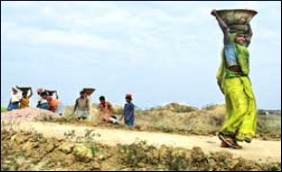|

|
Nepal reducing poverty faster than India: Oxford study
|
|

|
|
| Top Stories |
 |
|
|
|
Prasun Sonwalkar | 19 Mar, 2013
Nepal and Bangladesh are reducing poverty faster compared to India, according to a new study based on the multidimensional poverty index developed at the University of Oxford and used by the UN Development Programme (UNDP) in its Human Development Reports.
India also made significant progress in reducing poverty between 1999 and 2006, but at a rate that was less than one-third of the speed of its poorer neighbours, with a reduction in poverty rates of 1.2 percentage points per year [instead of 4.1 percent (Nepal) or 3.2 percent (Bangladesh)], the study found.
However, multidimensional poverty was reduced least in the poorest states - such as Bihar, Madhya Pradesh, Rajasthan, Uttar Pradesh and West Bengal - and among the poorest social groups, such as Scheduled Tribes, Muslims, female-headed households and larger households.
According to the study, even India's best-performing states - Kerala and Andhra Pradesh - progressed little more than half as fast as Nepal or Bangladesh in reducing multidimensional poverty, a release from the Oxford Poverty and Human development Initiative (OPHI), which conducted the study, said.
"The success of Nepal and Bangladesh in reducing poverty despite their relatively low income highlights the effectiveness of social policy investments combined with active civil society engagement," said Sabina Alkire, director of OPHI.
The poverty measure used by OPHI, the global Multidimensional Poverty Index (MPI), is said to be unique in capturing the simultaneous disadvantages experienced by poor people, such as malnutrition, education and sanitation, providing a high-resolution lens on their lives.
According to researcher Suman Seth, "From 1999-2006 India did very well in certain aspects of poverty reduction; for example, MPI among the scheduled caste groups showed a strong reduction, and poverty among the most destitute went down faster than the average."
He added: "However, it's still the case that the benefits of national poverty reduction have been enjoyed least by some of the poorer groups and regions."
OPHI added that India had not collected official data on MPI deprivations including malnutrition since 2005/6, making India's MPI the least up-to-date in South Asia.
The global MPI, which was developed by OPHI and UNDP in 2010 and has been published in Human Development reports since, assesses multidimensional poverty in 104 countries for which data since 2002 are available.
The study found that were 'star performers': the percentage of poor people in Nepal dropped from 64.7 percent to 44.2 percent between 2006 and 2011, 4.1 percentage points per year, while in Bangladesh poverty rates decreased by 3.2 percentage points per year between 2004 and 2007.
In addition to reducing the percentage of poor people, both Nepal and Bangladesh reduced the intensity of poverty. This means that even poor people were on average less poor - deprived in fewer things at the same time - than they had been before, an important element of multidimensional poverty analysis that provides a more balanced picture of poor people's lives, the release added.
The MPI is based on a deprivation score which reflects each person's overlapping deprivations in nutrition, child mortality, years of schooling, child school attendance, water, sanitation, electricity, cooking fuel, flooring, and assets.
A person is identified as 'multidimensionally poor' if he or she is deprived in one-third or more of ten (weighted) indicators.
(Prasun Sonwalkar can be contacted at prasun.sonwalkar@gmail.com)
|
|
|
| |
|
|
|
|
|
|
|
Poverty Alleviation
Matloob Alam | Thu Mar 21 06:54:06 2013
Its interesting to read that countries like Nepal and Bangladesh have managed to reduce poverty more compared to India in recent years.Micro-Finance Schemes started in Bangladesh is said to be doing well.These type of schemes should be followed agressively and small scale industries should be given priority when designing policies....because in crowded countries like India they work well.

Reducing poverty ratio
Priya | Thu Mar 21 03:34:46 2013
Good info, India should take more initiative to develop and improve the life style of the poor people and every one should contribute the effort domestically to encourage these kind of initiatives

|
|
|
|
|
|
|
| |
| Customs Exchange Rates |
| Currency |
Import |
Export |
US Dollar
|
84.35
|
82.60 |
UK Pound
|
106.35
|
102.90 |
Euro
|
92.50
|
89.35 |
| Japanese
Yen |
55.05 |
53.40 |
| As on 12 Oct, 2024 |
|
|
| Daily Poll |
 |
 |
| Do you think Indian businesses will be negatively affected by Trump's America First Policy? |
|
|
|
|
|
| Commented Stories |
 |
|
|
|
|
|
| |
|